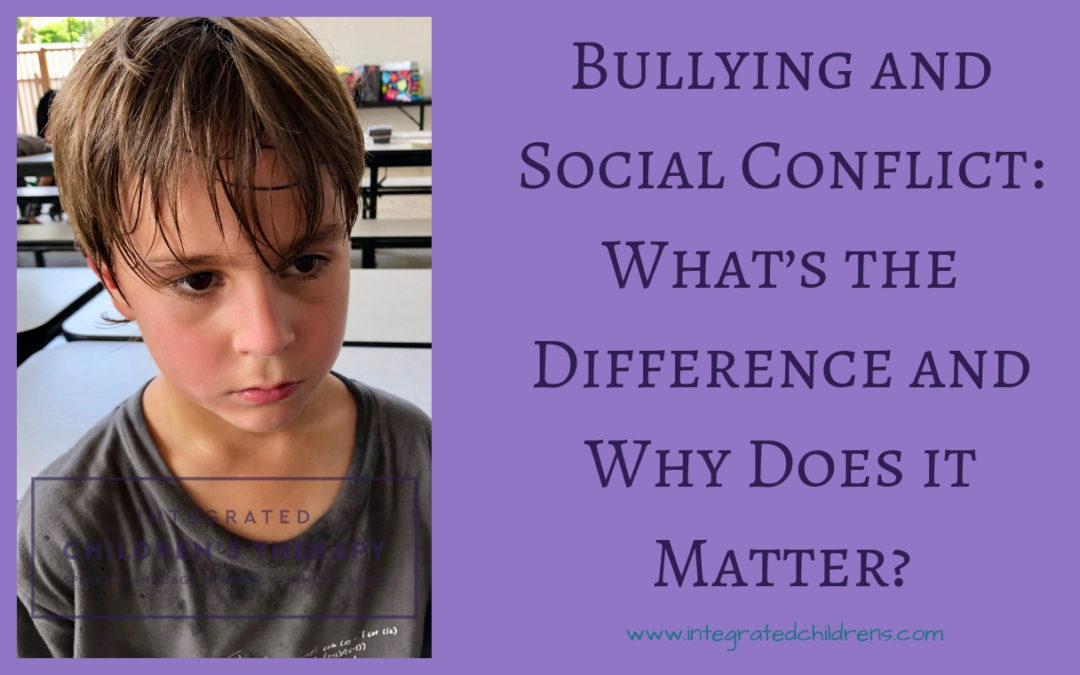Bullying is a buzz word these days and we are paying more attention than ever to the issue, for good reason. Bullying is a serious concern that needs to be dealt with head-on, but what if many of the instances we call bullying, especially with young kids and those who have developmental delays, are social conflicts that can be resolved before actual bullying ever begins?
Integrated Children’s Therapy’s Founder, Mandy Alvarez, M.S., SLP-CCC, is a speech language pathologist who emphasizes social and emotional development and has become a well-known speaker and teacher at local Miami schools on the subject of social conflict and bullying. Using information from Signe Whitson’s work, Mandy encourages educators, parents and kids to first learn the differences between rude, mean, and bullying behavior.
THE DIFFERENCE BETWEEN RUDE, MEAN AND BULLYING BEHAVIOR
“People need to know what bullying really is, and have an accurate definition to help them with a solution,” says Donna Brandt, a 4th grade teacher at The Cushman School who is familiar with Mandy’s work.
Mandy explains that oftentimes, behaviors labeled as bullying are better defined as socially-concerning situations that need support. While true bullying behavior—when a child is repeatedly aggressive, on purpose, towards a child viewed as “weaker”—is a serious issue, many conflicts between kids can be categorized as rude or mean behavior rather than bullying. Rude behavior (based on thoughtlessness or poor manners but not meant to hurt someone) or mean behavior (intentionally hurting someone’s feelings once or twice and usually motivated by angry feelings or low self-esteem) can often be resolved with careful, active support from educators and parents.
THE DANGER OF LABELS
Mariana Ureta, a parent who attended one of Mandy’s talks, says that one of the biggest take-away lessons for her was understanding that “kids can be mean and exclude other kids, but that doesn’t make them bullies. We are over-labeling, which creates other issues.”
Mandy cautions that labeling kids as “bullies” or “victims” is dangerous, because labels can become self-fulfilling. When we mis-assign these labels to kids, we disempower them. Kids wrongly labeled as bullies might take on a more aggressive attitude, while kids labeled as victims might embody feelings of weakness, powerlessness or a sense that others are out to get them.
STEP BACK, LISTEN AND INVESTIGATE
For parents, protecting our kids is an instinct. If our child comes to us upset, saying that another child hurt his feelings, it’s easy to have a strong, “mama/papa bear” reaction. It’s true that we need to protect our kids from bullying, but first we need to determine whether what’s happening is, in fact, bullying. “Parents need support so that they learn to empower their child and not make the situation worse,” says Dr. Tracy Ross, Director of the Laura Cushman Academy. If we overreact, we run the risk of creating problems between kids, parents, and teachers that might be avoidable.
Parent Mariana Ureta learned from Mandy that “as a parent you need to leave your emotions out of the situation and get the perspectives of all parties involved.” In order to this, we must first step back rather than react. Next, we listen: Allow our child to tell his side of the story. Empathize with him and brainstorm ways he can respond to similar situations in the future. Before we decide how to proceed, we investigate. We can do this in several ways: Keep an eye on the situation to see if it’s a recurring issue, talk to our child’s teacher to find out if there are ongoing issues between our child and other kids, or get the kids together to talk about what’s happening and help them find ways to deal with it.
When we approach social conflict in this way, we might find out that Child A is excluding Child B because Child B follows her everywhere and she is annoyed by it. We can then teach Child B how to respect others’ personal space, and equip Child A with tools to communicate when others’ behavior is bothering her. Or perhaps we discover that an incident of teasing was isolated and motivated by peer influence. Before we label it as bullying, we can work with the child who teased and set a boundary about teasing, and we can teach the child who was teased how to stand up for herself.
A NOTE ABOUT KIDS WITH DEVELOPMENTAL DELAYS
Kids with speech, language, sensory-motor or other delays are often the target of exclusion, teasing, or other mean behavior. Conversely, kids with developmental delays might lack social skills and their behavior can be misconstrued as mean when in reality they need support learning how to read, understand and communicate social cues. It is especially important to take this into account when investigating social conflict involving kids with developmental delays, and one of the reasons Mandy and her colleagues at Integrated Children’s Therapy became passionate about nurturing social and emotional development in their work.
Keep an eye out for an upcoming article about real bullying and how to equip your kids with tools for dealing with it. For more information about Mandy’s talks or her Social Conflict Curriculum for kids, please give us a call!


Recent Comments